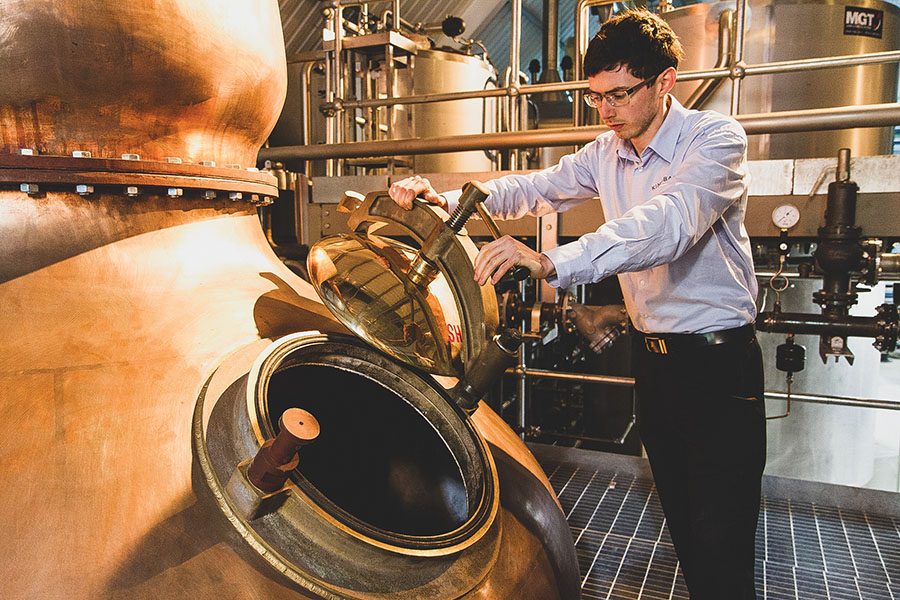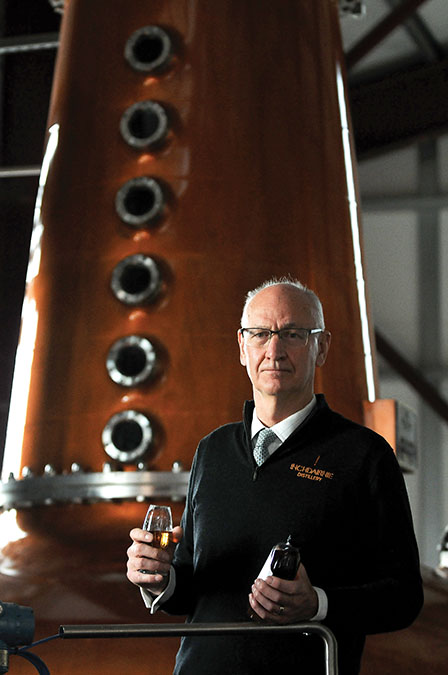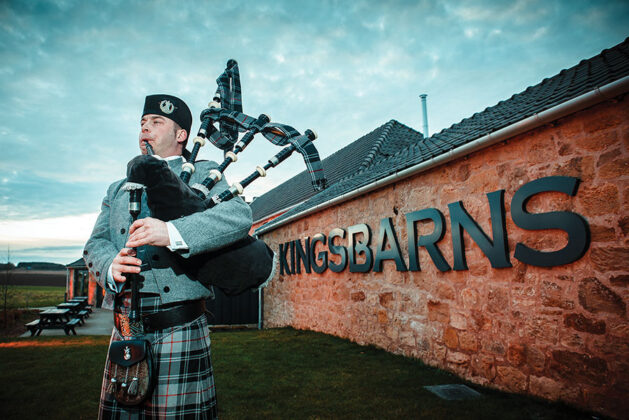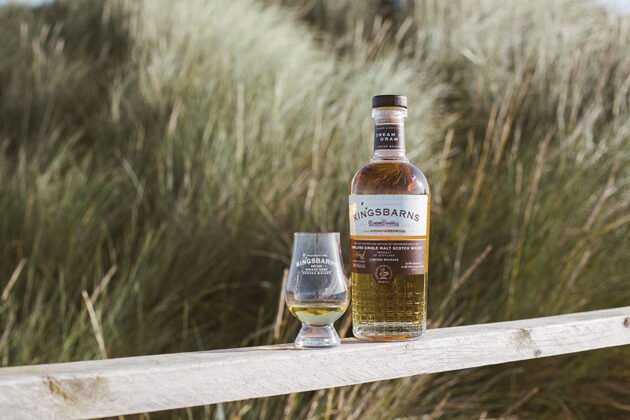The Kingdom of Fife, a fertile and historical peninsula in the Lowlands of eastern Scotland, has long punched above its weight when it comes to whisky. Sandwiched between the Firth of Forth and the Firth of Tay, this tapestry of gold and green farmland, windswept links (golf courses), formidable castles, and a chain of picturesque fishing villages is home to 360,000 Fifers and the best fish and chip shop on the planet.
It’s also where, back in 1494, during the dynasty of Scotland’s House of Stuart royal family, the first recorded reference to a distilled spirit in Scotland appeared: “Deliver eight bolls of malt to Friar John Cor wherewith to make aqua vitae.” With this excerpt from The Accounts of the Lord High Treasurer of Scotland, a Tironensian monk at Lindores Abbey in Fife entered Scotch history. A boll is an old Scottish measure of around six bushels of grain, and eight of them would make around fifty gallons of aqua vitae, the water of life. Friar Cor’s aqua vitae, a rough and distant cousin to the Scotch whisky we enjoy today, was destined for the court of King James IV, a Renaissance Stuart king and patron of alchemists and architects.
James IV had a keen and active interest in medicine and science, and given the primitive level of distillation in his time, the numerous references to aqua vitae after 1494 in his exchequer rolls probably reflect medicinal and medieval scientific use rather than social drinking. Falkland Palace, just eight miles south of Lindores Abbey, was commissioned by James IV and became the hunting and recreational grounds for the House of Stuart.
Fife’s six current distilleries are a microcosm of Scotch whisky’s past and present, experimenting with varieties of barley and other grains and a plethora of oak casks and production techniques. They include: the largest grain distillery in Europe, brought to life by the most influential family in Scotch whisky; Scotland’s only on-site brewery and single malt distillery; a modern yet decidedly traditional farm distillery; a well-respected independent bottler-turned-distiller; and a distillery integrated into a medieval abbey that was the genesis of the first document related to the production of spirits in Scotland.
Reviving Whisky’s Monastic Roots
The Falkland Palace estate is one of the farms that has grown barley for Lindores Abbey Distillery. The distillery, which began production in 2017, is built on top of some of the abbey’s ruins close by the Royal Burgh of Newburgh. It sits on the southern banks of the River Tay, with bucolic views across the Firth of Tay where the Highland whisky region begins. The owners and custodians of the abbey are Drew and Helen McKenzie Smith. The distillery is state of the art, with an impressive visitor center, abbey ruins across the road, and apple and plum orchards that pay homage to the hardworking horticultural origins of the 15th-century monks.
“We are delighted how things are progressing,” says Drew. “When we won the ‘best new make spirit in Scotland’ back in 2019, we knew we were doing something right. As for any distillery, big or small, their new make spirit is their DNA, so once we knew that was on track and we know our casks are premium quality then it’s down to us to manage those casks.” They appear to be managing them well. Lindore’s drams, for a youthful distillery, have been winning awards in Britain and the United States. Their core single malt, MCDXCIV (1494), is a marriage of three casks: bourbon, sherry, and wine barriques, and the distillery has invested in a plethora of different oak casks, releasing them in individual and blended cask bottlings.
The distillery’s first release was Aqua Vitae, a modern tribute to Friar Cor’s medieval water of life. Rather than venture down the gin lanes like several other Scotch distilleries, Lindores steeps its botanicals in their new make malt spirit. Herbs that grow nearby, like sweet cicely, lemon verbena, and cleavers are in the mix, along with dates and raisins.

Jim Swan’s Legacy
Drew acknowledges the impact and importance of their distilling consultant, Jim Swan. “Jim worked with the coppersmiths Forsyths of Rothes [in Speyside], to deliver us a fantastic distillery with which to work,” explains Drew. “Through Jim, we secured the very best contacts to source our premium casks. Our two small spirit stills are key factors, as is our fermentation time of up to 115 hours. And half of our barley is grown on our own farm; the rest is grown on nearby farms and malted in Fife.”
Dr. Jim Swan passed away in 2017. An independent spirits consultant, he spent decades in important scientific research for the Scotch whisky industry. In his later years, he brought his updated alchemy to startup distilleries in Scotland and around the world, including Penderyn in Wales, Kilchoman on Islay, Kavalan in Taiwan, and Amrut in India. With his knowledge of maturation and production, he solved a start-up distillery’s biggest dilemma aside from raising money: how to make young dram that tastes palatable.
His imprint has shaped another delightful young distillery on the opposite end of Fife from Lindores: Kingsbarns Distillery. “Kingsbarns whisky wouldn’t be the same without the input of Jim Swan,” distillery manager Peter Holroyd says. “He helped us enormously in the early days of the distillery to establish the spirit character we were striving for. From digging into how we mash and produce wort, to yeast choice and cask selection.”
Facing the North Sea on the East Neuk (corner) of the kingdom, Kingsbarns is six miles south of the university and golfing town of St. Andrews. A championship golf course, Kingsbarns, is next door, a natural occurrence in Fife. The distillery and visitor center are built in and around a farmstead and began production in 2015. The company’s artisan gin distillery and gin garden, Darnley’s, is next door.
Like Lindores, the whisky is not peated and generally follows the Lowland style: lighter and more floral than most drams north of the Highland Line. “We aim to produce a fruit-forward dram,” explains Holroyd, “a light and sweetly floral whisky in the classic Lowland style.”
Though a small operation (they fill about 34 barrels a week), they take their time mashing to produce a very clear wort. Then they ferment from 72 to 120 hours with two separate strains of yeast, which produces a lot of tropical fruit and summer berry flavor. They use a traditional double copper pot still distillation, running the stills extremely slowly to maximize contact with the copper. “It lets the copper rejuvenate when we’re not kicking the arse out of it,” says Holroyd. “We take a very high cut point (69%) on the spirit still, too.”

In addition to its limited-edition bottlings, Kingsbarns currently has two core whiskies. The Doocot is matured in ex-bourbon casks from the Heaven Hill distillery in Kentucky and ex-STR (shaved, toasted, and re-charred) Portuguese red wine barriques. “The whisky is very jammy and rich in color after maturation in this latter wood type,” according to Peter. Balcomie Sherry Cask is aged in ex-oloroso American oak sherry butts, and both are bottled at 46% ABV with no coloring or chill filtration, a typical practice for all of Fife’s new distilleries.
Doug Clement, a golf caddy, initiated the concept of a distillery at Kingsbarns back in 2009, and the project was eventually taken over by the Wemyss (pronounced weems) family of Fife. The Wemyss dynasty runs deep, stretching back to the 12th century, and they oversee a wide-ranging business empire in Scotland and around the world. In 2005, William Wemyss founded Wemyss Malts, a well-respected independent bottling and single malt blending company, with his sister, Isabella Wemyss as production director and blender. Their core family of blended malts includes The Hive, Spice King, and Peat Chimney, all cracking drams with stylish design.
History of the Haigs
The Wemyss family is connected to another Fife dynasty that has had a profound impact on Scotch whisky. One ancestor, Captain Wemyss, leased land to John Haig in 1824 to build the Cameronbridge Distillery at Windygates near the town of Leven on the Firth of Forth. John Haig installed the first continuous patent still, designed by his cousin Robert Stein, in 1829. Stein owned the industrial scale distillery at Kilbagie in Clackmannanshire, the county next to Fife.
The patent still, with improvements by Ireland’s Aeneas Coffey, would transform the Scotch whisky industry and lay the foundation for the international success of blended Scotch whisky.
The largest grain distillery in Europe, Cameronbridge is owned by Diageo and produces juice for Johnnie Walker, Haig, Dimple, Buchanan’s, and Bell’s whiskies. The white spirits plant distills Tanqueray and Gordon’s gins (for the UK and Europe), as well as Smirnoff and Sterling vodkas. And you can buy the humble Cameron Brig, the distillery’s grain whisky brand, in pubs and shops in the kingdom.
We’re not finished with the Haigs yet. In 1810, William Haig, John’s brother, built Seggie distillery in Guardbridge, just north of St. Andrews and overlooking the Eden River estuary. Seggie closed in 1860. Founder and CEO of Eden Mill Distillery, Paul Millar, with over 40 years experience in the industry, opened a brewery on the site in 2012, then added a microdistillery, thus becoming Scotland’s only on-site brewery and distillery. The first whisky was distilled in 2014 and set itself apart by distilling different washes of malted barley. Whisky distillation is currently on hold because Eden Mill is building a new distillery just yards away from the current location on the Eden campus of St. Andrews University. Expected to be completed in 2024, the distillery intends to be carbon neutral, secure its electricity from renewable sources, and capture the carbon dioxide from fermentation for use by the university.
Before leaving the East Neuk of Fife, I ask Kingsbarn’s Holroyd his thoughts on the state of whisky in the county. “Fife is the perfect place to produce Scotch malt whisky,” he says. “So much of the raw material is grown in this region. It’s perfect for barley cultivation with fertile ground and the right climate for the crop to ripen. The water quality is good for it, too. We have really focused on giving our whisky a sense of place by using locally grown barley and maturing all our whisky in Fife. From the outset we wanted to anchor the dram to the place it is made. It’s fantastic to see folks appreciating Fife whisky these days, as there has been a rebirth of distilling here over the last few years.”
A New Perspective on Scotch Whisky
Peter’s thoughts are personified by the secretive Daftmill Distillery, hidden in the farm country of central Fife, on the way to InchDairnie Distillery in Glenrothes. Owned by Francis and Ian Cuthbert, Daftmill is a traditional, working farm distillery (so no visitors) that started distilling in 2005. The farm grows all the barley for their classic Lowland style whiskies, and the spent grains are fed to the brothers’ herd of beef cattle. Just like the old ways. Everything is local, except for the oak casks that come from Heaven Hill in Kentucky.

At InchDairnie, on the outskirts of Glenrothes, technology, science, alchemy, and energy efficiency play important roles in what may be Scotland’s most innovative distillery. Managing director Ian Palmer began his career in 1978 at the Invergordon grain distillery in the Highlands and has over 40 years of whisky experience to call on. Distilling at InchDairnie started at the end of 2015, and their first whisky, RyeLaw Fife Single Grain Scotch Whisky, has recently been released.
“We chose Fife to locate our distillery because there were no preconceived ideas of what a Fife distillery was,” Palmer explains. “This gave us the freedom to do what we wanted to do. While still respecting our industry’s traditions, our approach to whisky making was driven from first principles as opposed to what we were expected to do. The first principle being our materials, our method, and our maturation: our three M’s. This is why we now use many different cereals and yeasts, our hammer milling, mash filter, bespoke Lomond still, and a wide variety of casks. All aimed for the only thing we have to offer, and that is a different flavor profile.”
Palmer explains that the distillery was built around their mash filter, which extracts more flavor and sugar, and can handle a variety of grain types. The wash and spirit stills at InchDairnie are fitted with two condensers instead of one in order to reuse energy and enhance flavor—more copper contact results in further removal of sulfury compounds. The Lomond still was designed in Italy and is used for distilling grains such as rye, wheat, and oats. Inside its neck are six copper bubble cap plates, where tiny vaporizations and condensations take place.
RyeLaw Single Grain Scotch Whisky (Vintage 2017) is the distillery’s first bottling, distilled from malted rye (over 51%) and barley and matured in new, charred oak casks from the Speyside Bourbon Cooperage in Jackson, Ohio. A new vintage will be released every year. KinGlassie, a well-peated single malt matured for eight years in bourbon and amontillado casks, will be released in 2025. InchDairnie Single Malt, reflecting the seasons of a single year through spring and winter barley, different yeasts, and oak casks, is planned for 2029. The PrinLaws Collection will be distillates from different cereals, oak casks, and yeasts.
Five hundred and twenty-nine years after Friar Cor distilled spirit fit for a king, the modern distillers of Fife blend tradition with innovation and a deep respect for a sense of place and the land. The kingdom is still punching above its weight.













